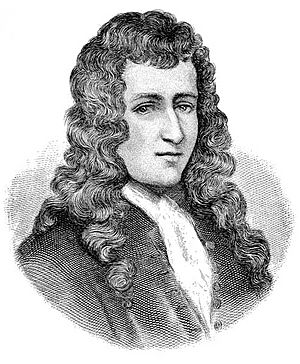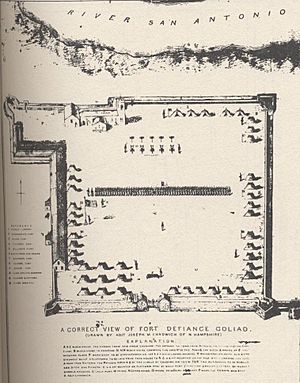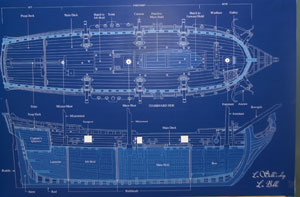French colonization of Texas facts for kids
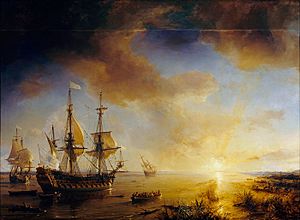
The French colonization of Texas started when explorer Robert Cavelier de La Salle built a fort in what is now southeastern Texas. This happened in 1685 near Arenosa Creek and Matagorda Bay. La Salle had planned to build his colony at the mouth of the Mississippi River. However, his maps were not accurate, and he made navigation mistakes. This caused his ships to land about 400 mi (640 km) west of his target, off the coast of Texas.
The colony faced many problems during its short life. These included attacks from Native American groups, diseases, and tough living conditions. From this fort, La Salle led several trips to find the Mississippi River. He didn't succeed, but he did explore much of the Rio Grande and parts of east Texas.
In 1686, while La Salle was away, the colony's last ship was wrecked. This meant the colonists could not get supplies from French colonies in the Caribbean. Conditions got worse. La Salle realized the colony needed help from French settlements in Illinois Country to the north. His last trip ended in early 1687 near the Brazos River. La Salle and five of his men were killed during a mutiny (a rebellion by his own men). A few men reached Illinois Country, but help never arrived at the fort. Most of the remaining colonists were killed in a Karankawa raid in late 1688. However, four children survived because the Karankawa adopted them.
Even though the colony only lasted three years, it gave France a claim to the land that is now Texas. Later, the United States tried to claim this area as part of the Louisiana Purchase. This was because of the early French colony, but their claim was not successful.
Spain found out about La Salle's mission in 1686. The Spanish Crown worried that the French colony could threaten Spain's control over New Spain and the southeastern part of North America. So, Spain paid for many trips to find and remove the French settlement. These trips didn't find the French at first, but they helped Spain learn more about the geography of the Gulf Coast.
When the Spanish finally found the remains of the French fort in 1689, they buried the cannons and burned the buildings. Years later, Spanish leaders built a presidio (a Spanish fort) at the same spot. When this presidio was left, the site of the French settlement was forgotten. Historians rediscovered the fort and dug it up in 1996. Now, it is an archaeological site. In 1995, researchers found La Salle's ship, La Belle, in Matagorda Bay. Parts of its hull were still mostly whole. They built a special cofferdam around it. This was the first time such a method was used in North America to dig up a ship as if it were on dry land. In 2000, digging revealed three of the fort's original buildings and the graves of three Frenchmen.
La Salle's Journeys
First Trip to the Mississippi
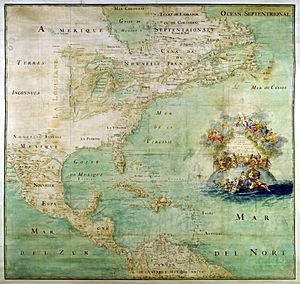
By the late 1600s, many European countries had claimed parts of North America. Spain claimed Florida, Mexico, and much of the southwestern continent. The northern and central Atlantic coast became the Thirteen Colonies (which later formed the USA). New France covered much of what is now eastern Canada and the central Illinois Country. The French worried that their colonies could be attacked by their neighbors.
In 1681, a French nobleman named Robert Cavelier de La Salle started a trip down the Mississippi River from New France. He first thought he would find a way to the Pacific Ocean. Instead, La Salle found a route to the Gulf of Mexico. Even though Hernando de Soto had explored and claimed this area for Spain 140 years earlier, La Salle claimed the Mississippi River valley for French King Louis XIV on April 9, 1682. He named the land Louisiana in the king's honor.
France needed to build a base at the mouth of the Mississippi. If not, Spain could control the entire Gulf of Mexico and threaten New France's southern borders. La Salle believed the Mississippi River was near the eastern edge of New Spain. When he returned to France in 1684, he suggested building a colony there. This colony could help spread Christianity among native peoples. It could also be a good spot to attack the Spanish province of Nueva Vizcaya and its rich silver mines. He argued that a small number of Frenchmen could invade New Spain by joining forces with some of the more than 15,000 Native Americans who were angry about Spanish enslavement. After Spain declared war on France in October 1667, King Louis agreed to La Salle's plan. La Salle was to return to North America and make sure "the Indians' allegiance to the crown" was strong, guide them to the "true faith," and keep peace among tribes.
Second Trip and Landing in Texas
La Salle first planned to sail to New France, then travel south overland to Illinois Country, and finally go down the Mississippi River. But to annoy Spain, King Louis XIV insisted that La Salle sail through the Gulf of Mexico. Spain considered this gulf their own property. La Salle had only asked for one ship, but on July 24, 1684, he left La Rochelle, France with four ships. These were the Le Joly (a 36-gun warship), the L'Aimable (a 300-ton supply ship), the La Belle (a smaller ship), and the St. François (a small boat). King Louis XIV provided Le Joly and La Belle. La Salle rented L'Aimable and St. François from French merchants for more space. Louis also sent 100 soldiers, full crews for the ships, and money to hire skilled workers. La Salle had to buy trade goods himself for meeting Native Americans.
The ships carried almost 300 people in total. This included soldiers, skilled workers, six Catholic missionaries, eight merchants, and over a dozen women and children. Soon after they left, France and Spain stopped fighting. King Louis was no longer interested in sending La Salle more help. Details of the trip were kept secret so Spain wouldn't find out. La Salle's naval commander, Sieur de Beaujeu, was annoyed that La Salle kept their destination a secret until they were far into the journey. Their disagreements grew when they reached Saint-Domingue (now Haiti) on the island of Hispaniola. They argued about where to anchor. Beaujeu sailed to another part of the island. This allowed Spanish privateers (pirates working for Spain) to capture the St. François. This ship was full of supplies, food, and tools for the colony.
During the 58-day trip, two people died from illness, and one woman gave birth. The trip to Saint-Domingue took longer than expected, and supplies ran low, especially after losing the St. François. La Salle had little money to buy more supplies. Finally, two merchants on board sold some of their trade goods to islanders and lent their profits to La Salle. To replace the men who had left, La Salle hired a few islanders to join the group.
In late November 1684, after La Salle recovered from a serious illness, the three remaining ships continued looking for the Mississippi River delta. Before they left Santo Domingo, local sailors warned them that strong Gulf currents flowed east. These currents would pull the ships toward the Florida straits unless they corrected their course. On December 18, the ships reached the Gulf of Mexico. They entered waters that Spain claimed as its own. No one on the trip had ever been in the Gulf of Mexico or knew how to navigate it. Because of bad maps, La Salle's earlier mistake about the Mississippi River's location, and over-correcting for the currents, the group failed to find the Mississippi. Instead, they landed at Matagorda Bay in early 1685, 400 mi (640 km) west of the Mississippi.
Building the First Settlement
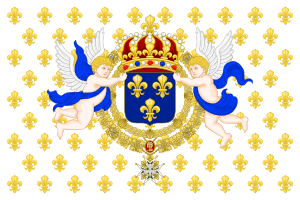
On February 20, the colonists stepped onto land for the first time in three months since leaving Saint-Domingue. They set up a temporary camp near where the Matagorda Island Lighthouse is today. Henri Joutel, who wrote about the trip, described his first view of Texas: "The country did not seem very favorable to me. It was flat and sandy but did nevertheless produce grass. There were several salt pools. We hardly saw any wild fowl except some cranes and Canadian (sic) geese which were not expecting us."
Against Beaujeu's advice, La Salle told La Belle and L'Aimable to go through a narrow, shallow pass to bring supplies closer to the camp. To make L'Aimables load lighter, its eight cannons and a small part of its cargo were removed. After La Belle successfully went through the pass, La Salle sent her pilot to L'Aimable to help with navigation. But L'Aimables captain refused the help. As L'Aimable sailed, a group of Karankawa people came and took some settlers. La Salle led a small group of soldiers to rescue them, leaving no one to guide L'Aimable. When he returned, he found L'Aimable stuck on a sandbar. La Salle heard that the captain had ordered the ship to sail forward after it hit the sandbar. He became sure that the captain had purposely grounded the ship.
For several days, the men tried to save the tools and supplies from L'Aimable. But a bad storm stopped them from getting more than food, cannons, gunpowder, and a small amount of goods. The ship sank on March 7. The French watched the Karankawa take things from the wreckage. When French soldiers went to the Native American village to get their supplies back, the villagers hid. The soldiers found the empty village. They not only got back the stolen goods but also took animal furs and two canoes. The angry Karankawa attacked, killing two Frenchmen and hurting others.
Beaujeu had finished his job of escorting the colonists across the ocean. He returned to France on the Joly in mid-March 1685. Many colonists chose to go back to France with him, leaving about 180 people behind. Beaujeu delivered a message from La Salle asking for more supplies. But French leaders had made peace with Spain and never replied. The remaining colonists suffered from dysentery (a severe stomach illness), and people died every day. Those who were well helped build simple homes and a temporary fort on Matagorda Island.
Building the Fort
On March 24, La Salle took 52 men in five canoes to find a safer place for a settlement. They found Garcitas Creek, which had fresh water and fish, and good soil along its banks. They named it Rivière aux Boeufs (Buffalo River) because of the nearby buffalo herds. The fort was built on a hill overlooking the creek, about 1.5 leagues (about 4.5 miles or 7.2 km) from its mouth. Two men died there, one from a rattlesnake bite and another from drowning while trying to fish. At night, the Karankawa would sometimes surround the camp and howl. But the soldiers could scare them away with a few gunshots. The fort has sometimes been called "Fort St. Louis," but that name was not used when the settlement was alive. It seems to be a name made up later.
In early June, La Salle called the rest of the colonists from the temporary camp to the new settlement site. Seventy people started the 50 mi (80 km) overland walk on June 12. All the supplies had to be carried from the Belle. This was very tiring work that was finally finished by mid-July. The last load was brought by the 30 men who had stayed behind to guard the ship. Even though trees grew near the site, they were not good for building. Wood had to be brought to the building site from several miles inland. Some wood was saved from the L'Aimable. By the end of July, over half of the settlers had died. Most died from not enough food and too much work.
The remaining settlers built a large, two-story building in the center of the settlement. The ground floor had three rooms: one for La Salle, one for the priests, and one for the officers. The upper floor was one large room used to store supplies. Around the fort were several smaller buildings for the other members of the group. The eight cannons, each weighing 700 to 1,200 lb (320 to 540 kg), had been saved from L'Aimable. They were placed around the colony for protection.
Challenges and La Salle's Death
For several months after the main camp was built, the colonists took short trips to explore the area. In late October 1685, La Salle decided to go on a longer trip. He loaded many of the remaining supplies onto the Belle. He took 50 men, plus the Belle's crew of 27 sailors. He left behind 34 men, women, and children. Most of the men traveled with La Salle in canoes, while the Belle followed further off the coast. After three days of travel, they heard about unfriendly Native Americans in the area. Twenty Frenchmen attacked a Native American village, where they found Spanish items. Several men died on this trip from eating prickly pear cactus fruit. The Karankawa killed a small group of men who had camped on shore, including the captain of the Belle.
From January to March 1686, La Salle and most of his men searched overland for the Mississippi River. They traveled toward the Rio Grande, possibly as far west as modern-day Langtry, Texas. The men asked local Native American tribes for information about where the Spanish were and where their mines were. They offered gifts and told stories that made the Spanish seem cruel and the French kind. When the group returned, they could not find the Belle where they had left her. They had to walk back to the fort.
The next month, they traveled east, hoping to find the Mississippi and return to Canada. During their travels, the group met the Caddo people. The Caddo gave the Frenchmen a map showing their land, their neighbors' land, and the location of the Mississippi River. The Caddo often made peace agreements with neighboring peoples and were peaceful with the French. While visiting the Caddo, the French met Jumano traders. These traders told them about what the Spanish were doing in New Mexico. These traders later told Spanish officials about the Frenchmen they had seen.
Four of the men left the group when they reached the Neches River. La Salle and one of his nephews became very sick, forcing the group to stop for two months. While the men recovered, the group ran low on food and gunpowder. In August, the eight surviving members of the trip returned to Fort Saint Louis. They had never left East Texas.
While La Salle was gone, six of those who had stayed on the Belle finally arrived at Fort Saint Louis. Many of the sailors did not know how to sail, and they ran the boat aground on Matagorda Peninsula. The survivors took a canoe to the fort, leaving the ship behind. The loss of their last ship left the settlers stuck on the Texas coast. They had no hope of getting help from the French colonies in the Caribbean Sea.
By early January 1687, fewer than 45 of the original 180 people were left in the colony. There were many arguments among them. La Salle believed their only hope was to walk overland to get help from New France. So, that month, he led a final trip to try to reach the Illinois Country. Fewer than 20 people stayed at Fort Saint Louis. These were mainly women, children, and those considered too weak. There were also seven soldiers and three missionaries La Salle was unhappy with. Seventeen men went on the trip, including La Salle, his brother, and two of his nephews.
While camping near modern-day Navasota on March 18, several men argued over sharing buffalo meat. That night, one expedition member killed one of La Salle's nephews and two other men in their sleep. The next day, La Salle was killed when he came to the camp to find out why his nephew was missing. More fighting led to the deaths of two other expedition members soon after. Two of the survivors, including Jean L'Archeveque, joined the Caddo. The remaining six men, led by Henri Joutel, made their way to Illinois Country. During their journey through Illinois to Canada, the men did not tell anyone that La Salle was dead. They reached France in the summer of 1688 and told King Louis about La Salle's death and the terrible conditions in the colony. King Louis did not send help.
What Happened Next
Only 15 or 16 people from the colony survived. Six returned to France. Nine others were captured by the Spanish, including the four children who had been saved by the Karankawa. The children were first taken to the Spanish viceroy (a high official) of New Spain, the Conde de Galve, who treated them as servants. Two of the boys, Pierre and Jean-Baptiste, later went back to France. Of the other Spanish captives, three became Spanish citizens and settled in New Mexico.
Even though the French colony was completely destroyed, Spain worried that France would try again. For the first time, the Spanish king allowed small outposts to be built in eastern Texas and at Pensacola. In 1722, the Spanish built a fort, Presidio La Bahia, and Mission Nuestra Señora del Espíritu Santo de Zúñiga at the same spot as Fort Saint Louis.
France did not give up its claims to Texas until November 3, 1762. On that date, France gave all its land west of the Mississippi River to Spain in the Treaty of Fontainebleau. This happened after France lost to Great Britain in the Seven Years' War. France also gave New France to Britain.
In 1803, three years after Spain had returned Louisiana to France, Napoleon sold the territory to the United States. The original agreement between Spain and France did not clearly state the borders of Louisiana. The descriptions in the documents were unclear and confusing. The United States insisted that its purchase included all the land France had claimed, including all of Texas. This disagreement was not settled until the Adams-Onís Treaty of 1819. In this treaty, Spain gave Florida to the United States. In return, the United States gave up its claim on Texas.
The official border of Texas was set at the Sabine River (which is the current border between Texas and Louisiana). It then followed the Red and Arkansas rivers to the 42nd parallel (which is California's current northern border).
Finding the Lost Fort and Ship
Digging Up the Fort
In 1908, a historian named Herbert Eugene Bolton identified an area along Garcitas Creek, near Matagorda Bay, as the location of Fort St. Louis. Other historians, both before and after Bolton, thought the fort was on the Lavaca River in Jackson County. Fifty years later, the University of Texas at Austin paid for some digging at Bolton's site, which was part of the Keeran ranch. Thousands of items were found. However, archaeologists could not tell the difference between French and Spanish items from the 1600s. No report on the findings was ever published. In the 1970s, Kathleen Gilmore, an archaeologist, looked at the items again. She found that while most were Spanish, some definitely matched items found from French and French-Canadian digs from the same time.
In late 1996, workers at the Keeran ranch used metal detectors and found eight cast-iron cannons buried near Garcitas Creek. After digging up the cannons, the Texas Historical Commission (THC) confirmed they were from Fort Saint Louis. In 2000, a THC dig found the locations of three of the buildings that had housed the French colony. They also found three graves dug by the Spanish.
Discovering the Ship La Belle
For many years, the THC had also been looking for the wreckage of La Belle. In 1995, the shipwreck was found in Matagorda Bay. Researchers dug up a 792 lb (359 kg) bronze cannon from the water. They also found musket balls, bronze pins, and trade beads. Large parts of the wooden hull were still whole. They were protected from the warm saltwater by layers of muddy dirt. This mud "essentially creat[ed] an oxygen-free time capsule." La Belle was the oldest French shipwreck found in the Western Hemisphere up to that time.
To help archaeologists get as many items as possible, a cofferdam was built around the ship. The cofferdam held back the bay waters. This allowed archaeologists to dig as if they were on land. This was the first time in North America that a shipwreck was dug up in dry conditions. Earlier shipwreck digs using cofferdams were done in Europe, but never on a ship as large as the Belle.
The National Underwater and Marine Agency searched for L'Aimable from 1997 to 1999. They found a promising spot, but the ship was buried under more than 25 ft (7.6 m) of sand and could not be reached.
See also
In Spanish: Colonización francesa de Texas para niños




